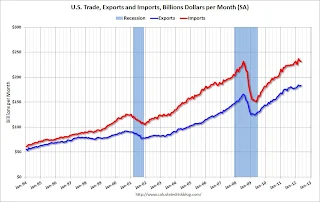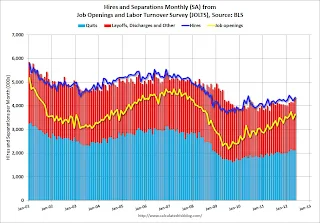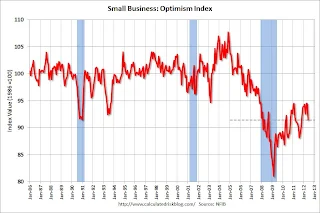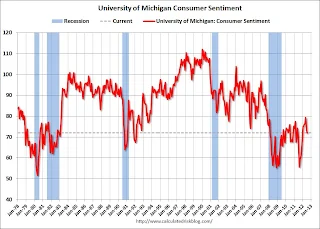Summary for Week ending July 13th: This was a very light week for economic news. The only significant report was the trade deficit for May, and that was at expectations. Import oil prices will fall further in June, so the downtrend in the deficit will probably continue for another month. Interestingly, exports to the euro area were actually up year-over-year for May, but that will probably be short lived.
Weekly initial unemployment claims were down sharply last week, but that was due to onetime factors. Consumer sentiment was down – and so was small business confidence – but those are fairly minor reports.
Enjoy the weekend and rest up - next week will be very busy with several key reports and testimony from Fed Chairman Ben Bernanke. Luckily there are a few housing reports next week, so all the data will not be grim (still seems weird to be writing about the housing recovery after all those years of being a housing Grizzly bear!).
Here is a summary of last week in graphs:
• Trade Deficit declines in May to $48.7 Billion
 Click on graph for larger image.
Click on graph for larger image.
The trade deficit was at the consensus forecast of $48.7 billion.
Oil averaged $107.91 per barrel in May, down from $109.94 per barrel in April. This will decline further in June. The trade deficit with China increased to $26 billion in May, up from $24.9 billion in May 2011. Once again most of the trade deficit is due to oil and China.
Exports to the euro area were $17 billion in May, up from $16.4 billion in May 2011; so the euro area recession didn't lead to less US exports to the euro area in May.
• BLS: Job Openings increased in May
 Job openings increased in May to 3.642 million, up from 3.447 million in April. The number of job openings (yellow) has generally been trending up, and openings are up about 18% year-over-year compared to May 2011.
Job openings increased in May to 3.642 million, up from 3.447 million in April. The number of job openings (yellow) has generally been trending up, and openings are up about 18% year-over-year compared to May 2011.
Quits increased slightly in May, and quits are now up about 6% year-over-year. These are voluntary separations and more quits might indicate some improvement in the labor market. (see light blue columns at bottom of graph for trend for "quits").
All current employment graphs
• NFIB: Small Business Optimism Index declines in June
 This graph shows the small business optimism index since 1986. The index decreased to 91.4 in June from 94.4 in May.
This graph shows the small business optimism index since 1986. The index decreased to 91.4 in June from 94.4 in May.
This index remains low, and once again, lack of demand is the biggest problem for small businesses. (In the survey, the "single most important problem" was "poor sales".
Note: Small businesses have a larger percentage of real estate and retail related companies than the overall economy and that has contributed to this index remaining low.
• Weekly Initial Unemployment Claims decline to 350,000 due to onetime factors
From MarketWatch: "onetime factors such as fewer auto-sector layoffs than normal likely caused the sharp decline, the Labor Department said Thursday".
 The dashed line on the graph is the current 4-week average. The four-week average of weekly unemployment claims declined to 376,500.
The dashed line on the graph is the current 4-week average. The four-week average of weekly unemployment claims declined to 376,500.
The sharp decline was probably due to onetime factors, plus this included the holiday week.
This was well below the consensus forecast of 375,000. With the holiday week and onetime factors, it is difficult to tell if there is any improvement - but this is the lowest level for the four week average since May.
All current Employment Graphs
• Consumer Sentiment declines in July to 72.0

The preliminary Reuters / University of Michigan consumer sentiment index for July declined to 72.0, down from the June reading of 73.2.
This was below the consensus forecast of 73.5 and the lowest level this year. Overall sentiment is still weak - probably due to a combination of the high unemployment rate and the sluggish economy.
• Other Economic Stories ...
• CoreLogic: Negative Equity Decreases in Q1 2012
• WSJ: The U.S. Housing Bust Is Over
• Q1 2012: Mortgage Equity Withdrawal strongly negative
• LPS: Mortgages in Foreclosure still near record high, Much higher in Judicial States


Weekly initial unemployment claims were down sharply last week, but that was due to onetime factors. Consumer sentiment was down – and so was small business confidence – but those are fairly minor reports.
Enjoy the weekend and rest up - next week will be very busy with several key reports and testimony from Fed Chairman Ben Bernanke. Luckily there are a few housing reports next week, so all the data will not be grim (still seems weird to be writing about the housing recovery after all those years of being a housing Grizzly bear!).
Here is a summary of last week in graphs:
• Trade Deficit declines in May to $48.7 Billion
 Click on graph for larger image.
Click on graph for larger image.The trade deficit was at the consensus forecast of $48.7 billion.
Oil averaged $107.91 per barrel in May, down from $109.94 per barrel in April. This will decline further in June. The trade deficit with China increased to $26 billion in May, up from $24.9 billion in May 2011. Once again most of the trade deficit is due to oil and China.
Exports to the euro area were $17 billion in May, up from $16.4 billion in May 2011; so the euro area recession didn't lead to less US exports to the euro area in May.
• BLS: Job Openings increased in May
 Job openings increased in May to 3.642 million, up from 3.447 million in April. The number of job openings (yellow) has generally been trending up, and openings are up about 18% year-over-year compared to May 2011.
Job openings increased in May to 3.642 million, up from 3.447 million in April. The number of job openings (yellow) has generally been trending up, and openings are up about 18% year-over-year compared to May 2011.Quits increased slightly in May, and quits are now up about 6% year-over-year. These are voluntary separations and more quits might indicate some improvement in the labor market. (see light blue columns at bottom of graph for trend for "quits").
• NFIB: Small Business Optimism Index declines in June
 This graph shows the small business optimism index since 1986. The index decreased to 91.4 in June from 94.4 in May.
This graph shows the small business optimism index since 1986. The index decreased to 91.4 in June from 94.4 in May.This index remains low, and once again, lack of demand is the biggest problem for small businesses. (In the survey, the "single most important problem" was "poor sales".
Note: Small businesses have a larger percentage of real estate and retail related companies than the overall economy and that has contributed to this index remaining low.
• Weekly Initial Unemployment Claims decline to 350,000 due to onetime factors
From MarketWatch: "onetime factors such as fewer auto-sector layoffs than normal likely caused the sharp decline, the Labor Department said Thursday".
 The dashed line on the graph is the current 4-week average. The four-week average of weekly unemployment claims declined to 376,500.
The dashed line on the graph is the current 4-week average. The four-week average of weekly unemployment claims declined to 376,500.The sharp decline was probably due to onetime factors, plus this included the holiday week.
This was well below the consensus forecast of 375,000. With the holiday week and onetime factors, it is difficult to tell if there is any improvement - but this is the lowest level for the four week average since May.
• Consumer Sentiment declines in July to 72.0

The preliminary Reuters / University of Michigan consumer sentiment index for July declined to 72.0, down from the June reading of 73.2.
This was below the consensus forecast of 73.5 and the lowest level this year. Overall sentiment is still weak - probably due to a combination of the high unemployment rate and the sluggish economy.
• Other Economic Stories ...
• CoreLogic: Negative Equity Decreases in Q1 2012
• WSJ: The U.S. Housing Bust Is Over
• Q1 2012: Mortgage Equity Withdrawal strongly negative
• LPS: Mortgages in Foreclosure still near record high, Much higher in Judicial States
Comments